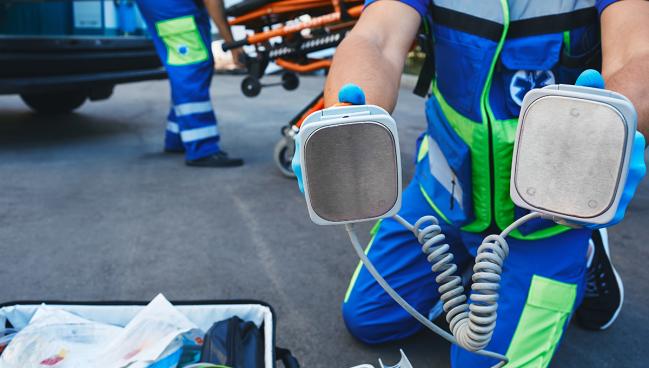Extracorporeal CPR Hits Snag in INCEPTION, but Some See Unmet Promise
Lack of a protocol and the prolonged times to start of care may have torpedoed a promising study, one expert says.

Compared with cardiac arrest patients assigned to conventional CPR, those assigned to receive extracorporeal CPR (eCPR) after arrival at the hospital had similar rates of survival with favorable neurologic outcome in the Dutch INCEPTION trial.
The addition of extracorporeal membrane oxygenation (ECMO) to CPR is meant to restore perfusion and limit brain injury when there is no return of spontaneous circulation after standard advanced life support. But evidence to support its value in clinical practice has been inconclusive, note Martje M. Suverein, MD (Maastricht University Medical Center, the Netherlands), and colleagues.
They conducted the multicenter INCEPTION trial with the expectation, based on prior studies, that eCPR would increase 30-day survival to 30%, far beyond the typical 8% to 10% survival rate seen with standard CPR in OHCA.
Those hopes fell short, however. Instead, Suverein and colleagues found a nonsignificant 4% difference between groups, suggesting that despite the appeal of eCPR, major gains are “not self-evident when extracorporeal CPR is pragmatically implemented, even in cardiosurgical centers where providers are experienced in its use.”
Their findings stand in contrast to the ARREST trial, a small single-center US trial that used a highly standardized eCPR pathway that was associated with 36% higher survival compared with conventional CPR.
“It's very common in many centers that these patients are considered dead when they arrive,” Demetris Yannopoulos, MD (University of Minnesota Medical School, Minneapolis), the lead author of ARREST, told TCTMD. He added that “the devil is in the details” when it comes to setting up and applying a cohesive system for eCPR, which should include a reorganization of emergency response infrastructure and centralization of care.
Suverein and colleagues acknowledge in the paper that they did not have a protocol for emergency medical services (EMS) and hospital staff, which Yannopoulos called “mind-boggling” and said is likely a major factor in why the trial was unsuccessful. The authors say although it may be seen as a limitation, this feature “may also increase the generalizability of the resuscitation procedures and extracorporeal CPR.”
Yannopoulos disagreed vehemently.
“INCEPTION had the potential, if it was done in a very well-organized system, to show remarkable results because the mean time between cardiac arrest and arrival to the hospital was 36 minutes. The average time that it should take for a patient to be cannulated and put on pump support is about 7 to 10 minutes. So, that would have put people in the 45 minutes total CPR duration before being on ECMO,” he said. “Our study and others have shown that if you put people on ECMO within 45 minutes, their chance for survival is close to 70%.”
The median time from start of arrest to start of ECMO flow in INCEPTION was 74 minutes. In the paper, Suverein and colleagues acknowledge that their times to initiation of cannulation and time to start of oxygen flow were longer than those of ARREST and another single-center trial conducted in Prague that was terminated early for futility when eCPR did not significantly improve outcomes. They say this is a reflection of “ differences in such factors as team experience, logistics, and caseload.”
In an accompanying editorial, John F. Keaney Jr, MD (Brigham and Women’s Hospital, Boston, MA), and Thomas Münzel, MD (University Medical Center Mainz, Germany), contend that the mixed findings from the three trials should not be taken as an indication that eCPR is not useful in some patients.
“Collectively, results of all three randomized trials showed a numerical advantage in their respective primary outcomes in favor of extracorporeal CPR as compared with conventional therapy,” they write. “Thus, it is possible that larger trials are needed for the statistical power necessary to capture any benefit associated with extracorporeal CPR as compared with conventional CPR.”
Few Between-Group Differences
For INCEPTION, patients (mean age 54 years in the eCPR group and 57 years in the conventional CPR group; 90% and 89% men, respectively) were randomized to receive e CPR (n = 70) or conventional CPR (n = 64) after arriving via EMS at one of 10 participating cardiosurgical centers.
All had witnessed OHCA, CPR started within minutes, and an initial ventricular fibrillation, ventricular tachycardia, or a shockable rhythm detectable on defibrillator, but no return of spontaneous circulation despite 15 minutes of advanced CPR. The cause of arrest was acute MI in 73% of those in the eCPR group and 81% in the conventional CPR group.
At 30 days, the percentage of patients meeting the primary outcome of survival with a Cerebral Performance Category score of 1 or 2 (normal or disabled but independent) was 20% in the eCPR group and 16% in the conventional CPR group (P = 0.52).
Compared with standard CPR, more of those who received eCPR survived until admission to the ICU. However, the number patients who actually survived to discharge from the ICU was small and similar between groups, as was the number who survived to hospital discharge.
At 6 months, survival with a favorable neurologic outcome also showed no significant difference between treatment groups.
A Call for Training and Systems of Excellence
According to Suverein and colleagues, another difference between their study and the ARREST and Prague trials is a far lower caseload at the participating hospitals. During the study period of May 2017 through February 2021, there were 51 cannulations attempted across the 10 centers, with 46 being successful. The small number of patients points to another issue, say Keaney and Münzel, namely that “we have not adequately identified the specific subsets of patients who may benefit from extracorporeal CPR.”
But Yannopoulos told TCTMD that a more important future endeavor is understanding and perfecting the aggressive cycle of care needed once eCPR begins. He believes many patients are withdrawn from support too soon at the discretion of neurologists based on the conclusion that they cannot recover. In his experience, it’s not uncommon to have reversible bleeding or traumatic complications that can be managed and pave the way for survival.
“I really think with this type of therapy, it's a matter of training that isn’t really happening right now,” he said. “In addition, you have to create systems of excellence, and effectively, you need to build a program slowly by looking at the idiosyncrasies of your own hospital, your own city, etc, to be successful.”
L.A. McKeown is a Senior Medical Journalist for TCTMD, the Section Editor of CV Team Forum, and Senior Medical…
Read Full BioSources
Suverein MM, Delnoij TSR, Lorusso R, et al. Early extracorporeal CPR for refractory out-of-hospital cardiac arrest. N Engl J Med. 2023;388:299-309.
Keaney JK, Münzel T. Extracorporeal CPR in out-of-hospital cardiac arrest— still on life support? N Engl J Med. 2023;388:370-371.
Disclosures
- Suverein, Münzel, and Yannopoulos report no relevant conflicts of interest.
- Keaney reports being employed by the New England Journal of Medicine as an associate editor.





Zend Mayin